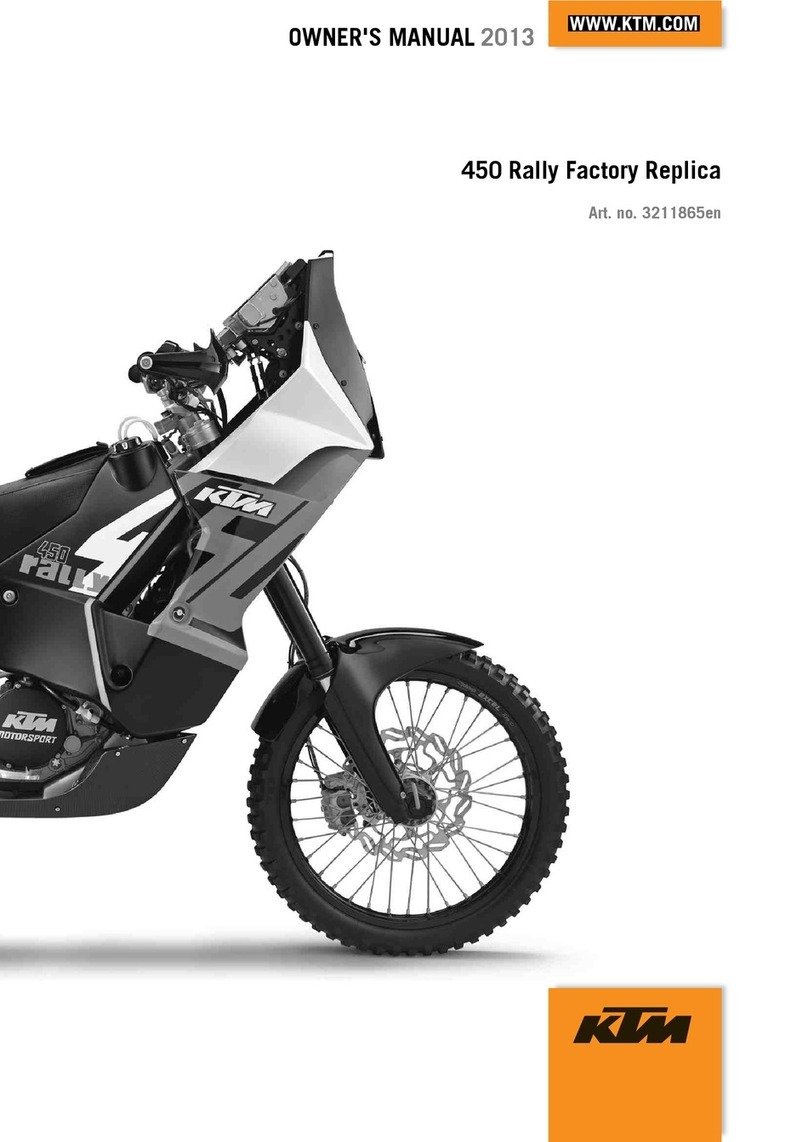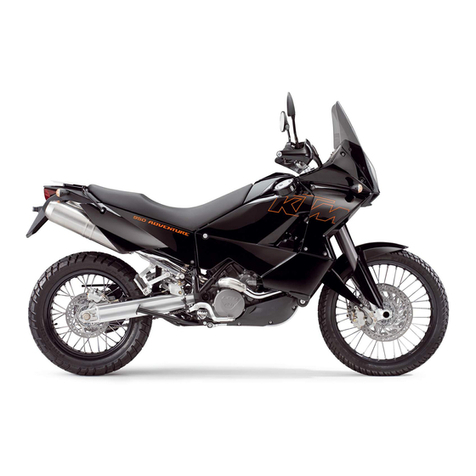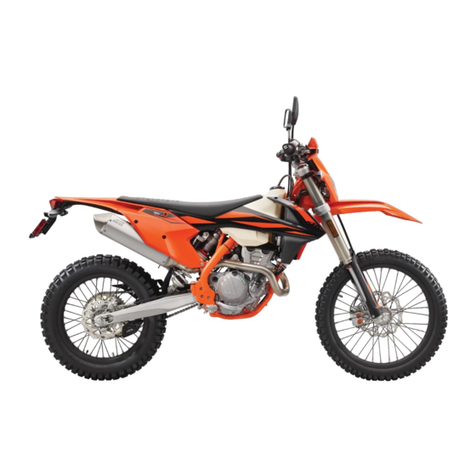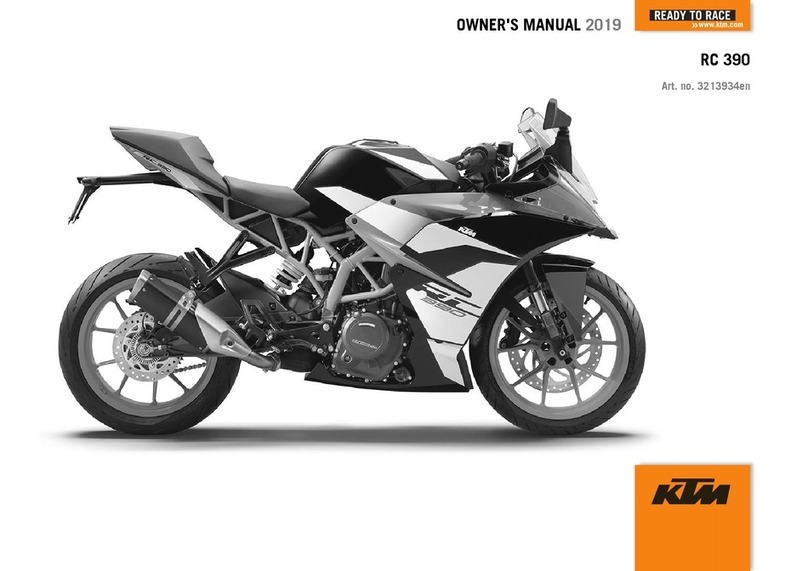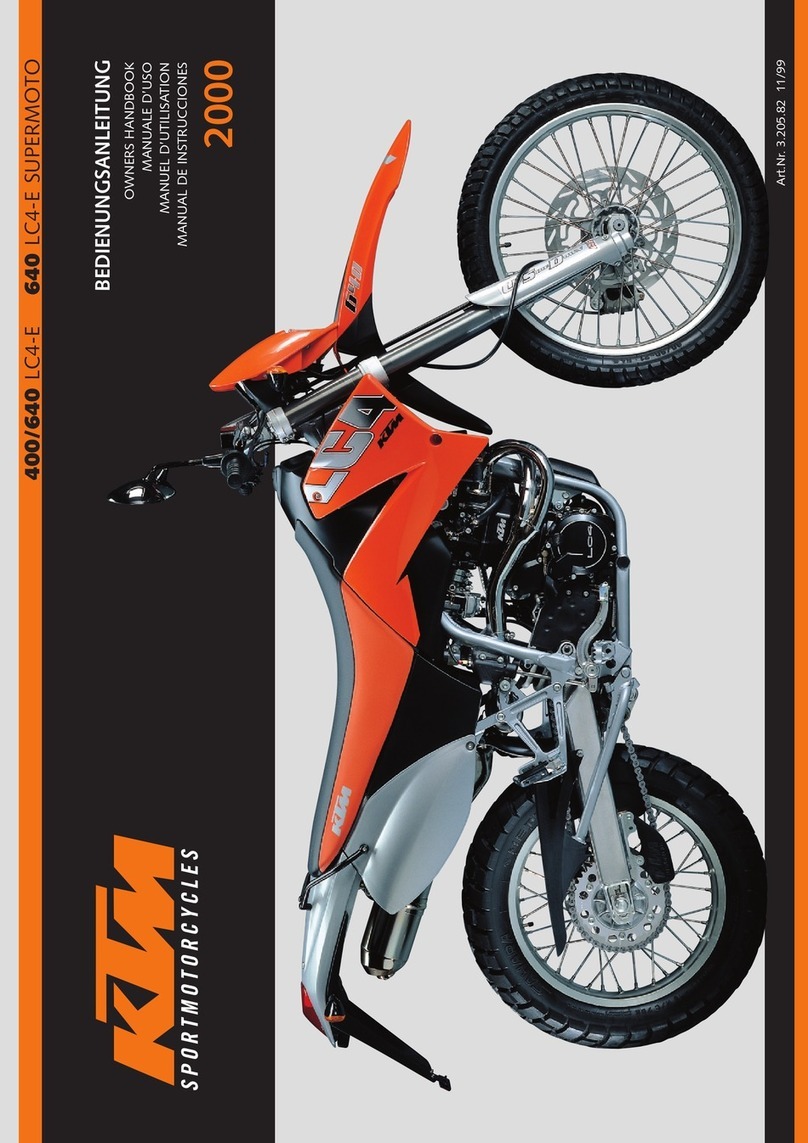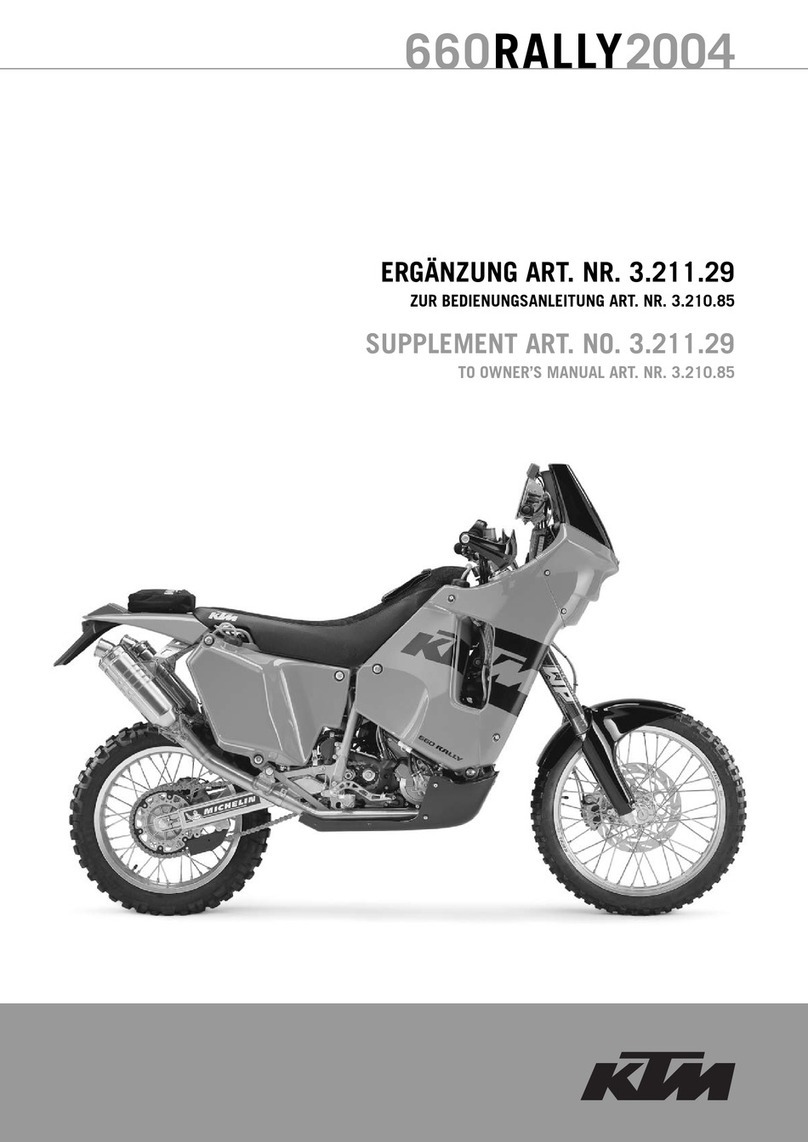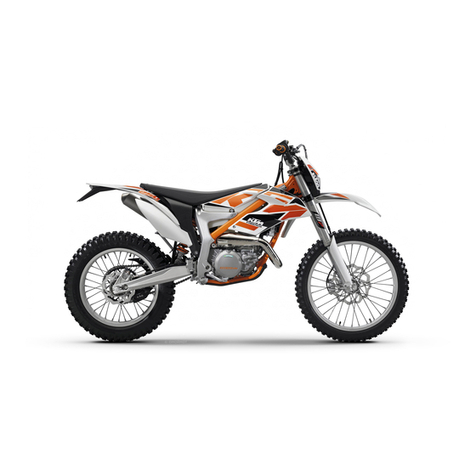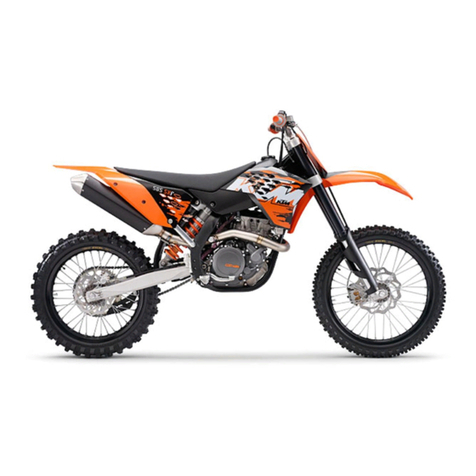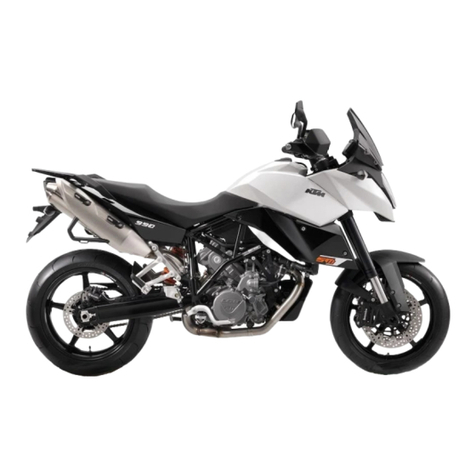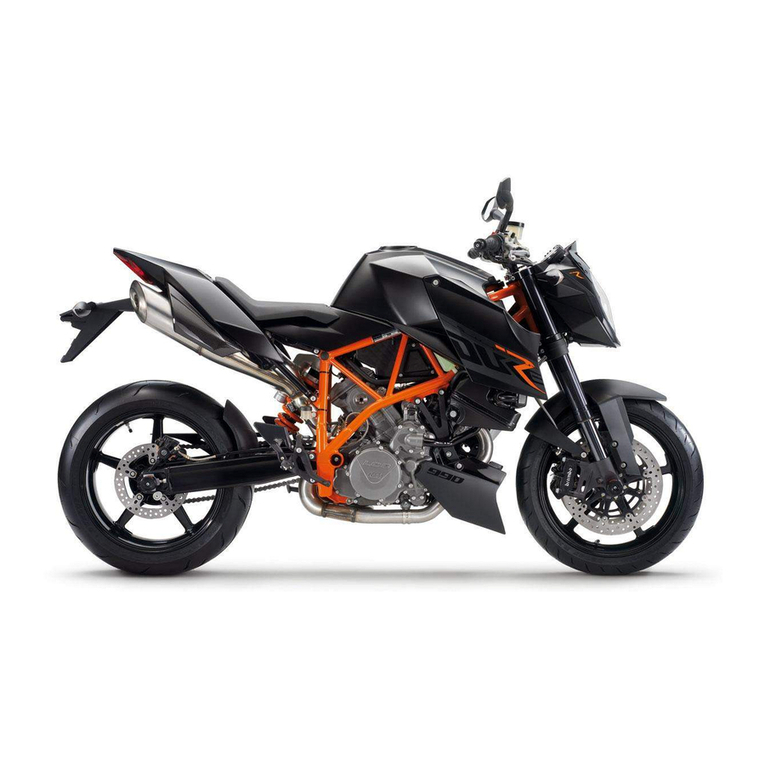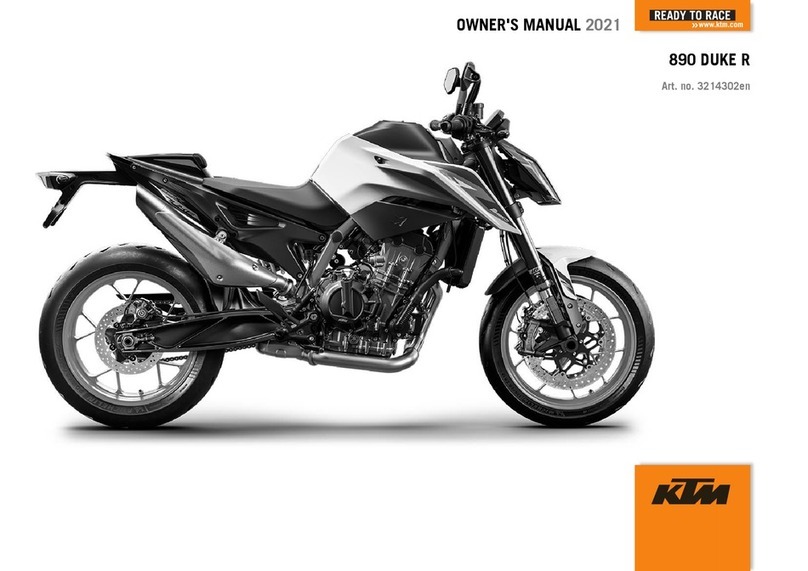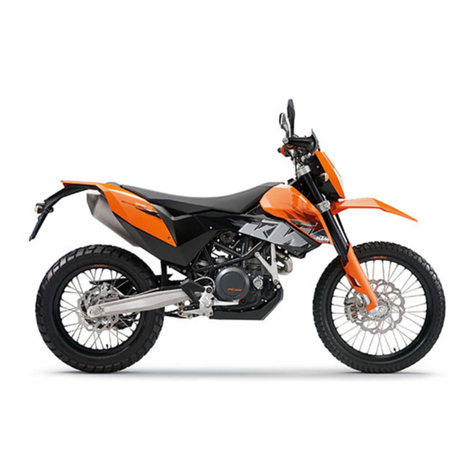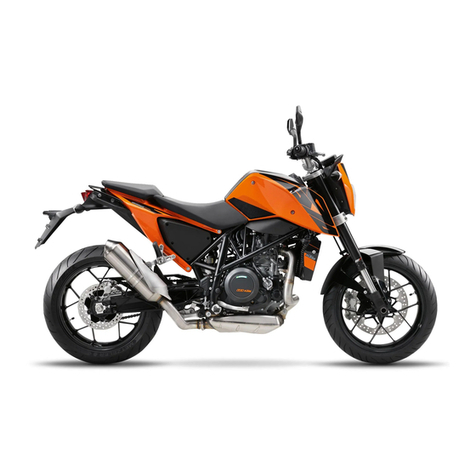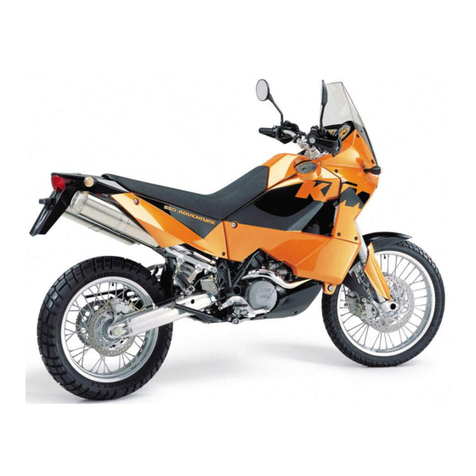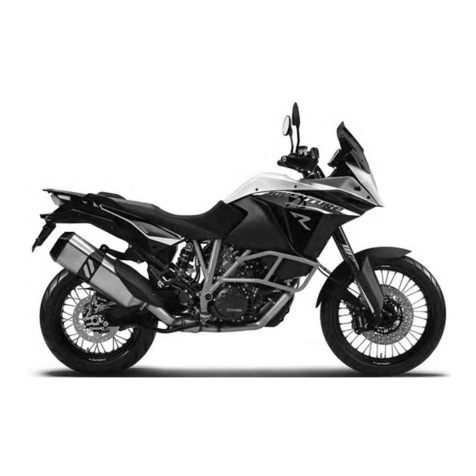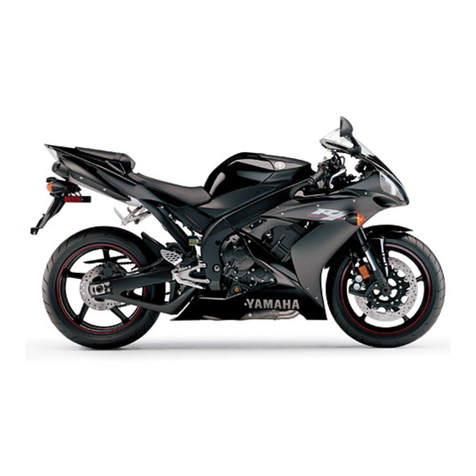ENGLISH
3
Page
IMPORTANT NOTES . . . . . . . . . . . . . . . . . . . . . . . . . . . . . .1
SERIAL NUMBER LOCATING . . . . . . . . . . . . . . . . . . . . . . .4
Frame number . . . . . . . . . . . . . . . . . . . . . . . . . . . . . . . .4
Engine number, engine type . . . . . . . . . . . . . . . . . . . . . .4
OPERATION INSTRUMENTS . . . . . . . . . . . . . . . . . . . . . . .4
Clutch lever . . . . . . . . . . . . . . . . . . . . . . . . . . . . . . . . . . .4
Hand decompression lever . . . . . . . . . . . . . . . . . . . . . . .4
Choke lever . . . . . . . . . . . . . . . . . . . . . . . . . . . . . . . . . . .5
Hand brake lever . . . . . . . . . . . . . . . . . . . . . . . . . . . . . . .5
Speedometer, tachometer . . . . . . . . . . . . . . . . . . . . . . . .5
Indicator lamps . . . . . . . . . . . . . . . . . . . . . . . . . . . . . . . .5
Ignition lock, steering lock . . . . . . . . . . . . . . . . . . . . . . . .6
Combination switch . . . . . . . . . . . . . . . . . . . . . . . . . . . .6
Starter tip switch, emergency OFF switch . . . . . . . . . . . .6
Headlight range adjustment . . . . . . . . . . . . . . . . . . . . . .7
Filler cap . . . . . . . . . . . . . . . . . . . . . . . . . . . . . . . . . . . . .7
Fuel . . . . . . . . . . . . . . . . . . . . . . . . . . . . . . . . . . . . . . . . .7
Fuel tap . . . . . . . . . . . . . . . . . . . . . . . . . . . . . . . . . . . . . .8
Hot start device . . . . . . . . . . . . . . . . . . . . . . . . . . . . . . . .8
Shift lever . . . . . . . . . . . . . . . . . . . . . . . . . . . . . . . . . . . .8
Kickstarter . . . . . . . . . . . . . . . . . . . . . . . . . . . . . . . . . . . .8
Foot brake pedal . . . . . . . . . . . . . . . . . . . . . . . . . . . . . . .8
Compression damping of fork . . . . . . . . . . . . . . . . . . . . .9
Rebound damping of fork . . . . . . . . . . . . . . . . . . . . . . . .9
Compression damping of shock absorber . . . . . . . . . . . .9
Rebound damping of shock absorber . . . . . . . . . . . . . . .9
Standard adjustment of fork and shock absorber . . . . . . .9
Helmet lock . . . . . . . . . . . . . . . . . . . . . . . . . . . . . . . . . .10
Passenger handles . . . . . . . . . . . . . . . . . . . . . . . . . . . . .10
DRIVING INSTRUCTIONS . . . . . . . . . . . . . . . . . . . . . . . . .11
LUBRICATION AND MAINTENANCE SCHEDULE . . . . . . .15
MAINTENANCE WORK ON CHASSIS AND ENGINE . . . . .16
Removing the seat . . . . . . . . . . . . . . . . . . . . . . . . . . . .16
Tool kit . . . . . . . . . . . . . . . . . . . . . . . . . . . . . . . . . . . . .16
Checking and adjusting the steering head bearing . . . .17
Changing the spring preload of the shock absorber . . . .17
Checking the rubber ring on the shock absorber . . . . . .18
Lubricate rear shock absorber link . . . . . . . . . . . . . . . . .18
Checking chain tension . . . . . . . . . . . . . . . . . . . . . . . . .18
Correcting chain tension . . . . . . . . . . . . . . . . . . . . . . . .18
Chain maintenance . . . . . . . . . . . . . . . . . . . . . . . . . . . .19
Chain wear . . . . . . . . . . . . . . . . . . . . . . . . . . . . . . . . . .19
Maintaining chain tension eccentrics . . . . . . . . . . . . . . .19
General information about disc brakes . . . . . . . . . . . . .20
Checking of brake fluid level - front brake . . . . . . . . . .20
Page
Refilling the front brake fluid reservoir . . . . . . . . . . . . .21
Checking the front brake pads . . . . . . . . . . . . . . . . . . .21
Replacing front brake pads . . . . . . . . . . . . . . . . . . . . . .21
Changing the basic position of the brake pedal . . . . . . .22
Checking the rear brake fluid level . . . . . . . . . . . . . . . .22
Refilling the rear brake fluid reservoir . . . . . . . . . . . . . .22
Checking the rear brake pads . . . . . . . . . . . . . . . . . . . .22
Replacing the rear brake pads . . . . . . . . . . . . . . . . . . . .22
Dismounting and mounting the front wheel . . . . . . . . .23
Dismounting and mounting the rear wheel . . . . . . . . . .24
Checking the shock absorption rubbers in the rear hub
. . .24
Tires, air pressure . . . . . . . . . . . . . . . . . . . . . . . . . . . . .24
Checking spoke tension . . . . . . . . . . . . . . . . . . . . . . . .25
Cooling system . . . . . . . . . . . . . . . . . . . . . . . . . . . . . . .25
Cooling liquid level check . . . . . . . . . . . . . . . . . . . . . . .26
Fuse / fan . . . . . . . . . . . . . . . . . . . . . . . . . . . . . . . . . . .26
Main fuse . . . . . . . . . . . . . . . . . . . . . . . . . . . . . . . . . . .26
Battery . . . . . . . . . . . . . . . . . . . . . . . . . . . . . . . . . . . . .27
Charging the battery . . . . . . . . . . . . . . . . . . . . . . . . . . .27
Removing the headlight mask . . . . . . . . . . . . . . . . . . . .28
Replacing the headlight lamp . . . . . . . . . . . . . . . . . . . .28
Replacing the instrument light . . . . . . . . . . . . . . . . . . . .28
Replacing the indicator lamps . . . . . . . . . . . . . . . . . . . .28
Cleaning the air filter . . . . . . . . . . . . . . . . . . . . . . . . . . .29
Adjusting idle speed . . . . . . . . . . . . . . . . . . . . . . . . . . .29
Adjusting the throttle cable . . . . . . . . . . . . . . . . . . . . . .29
Adjusting the choke cable . . . . . . . . . . . . . . . . . . . . . . .29
Adjusting the clutch cable . . . . . . . . . . . . . . . . . . . . . . .30
Checking the setting of the hand decompression cable .30
Oil circuit . . . . . . . . . . . . . . . . . . . . . . . . . . . . . . . . . . .30
Engine oil . . . . . . . . . . . . . . . . . . . . . . . . . . . . . . . . . . .31
Checking the engine oil level . . . . . . . . . . . . . . . . . . . . .31
Changing the engine oil and bleeding the oil system . . .31
Changing oil filter . . . . . . . . . . . . . . . . . . . . . . . . . . . . .32
Changing the fine screen filter . . . . . . . . . . . . . . . . . . .32
TROUBLE SHOOTING . . . . . . . . . . . . . . . . . . . . . . . . . . .33
CLEANING . . . . . . . . . . . . . . . . . . . . . . . . . . . . . . . . . . . .35
STORAGE . . . . . . . . . . . . . . . . . . . . . . . . . . . . . . . . . . . . .35
Re-initation after time of storage . . . . . . . . . . . . . . . . .35
TECHNICAL SPECIFICATIONS - CHASSIS . . . . . . . . . . . . .36
TECHNICAL SPECIFICATIONS - ENGINE . . . . . . . . . . . . . .37
NOTICES . . . . . . . . . . . . . . . . . . . . . . . . . . . . . . . . . . . . . .39
WIRING DIAGRAMM . . . . . . . . . . . . . . . . . . . . . . . . . . . .40
INDEX
